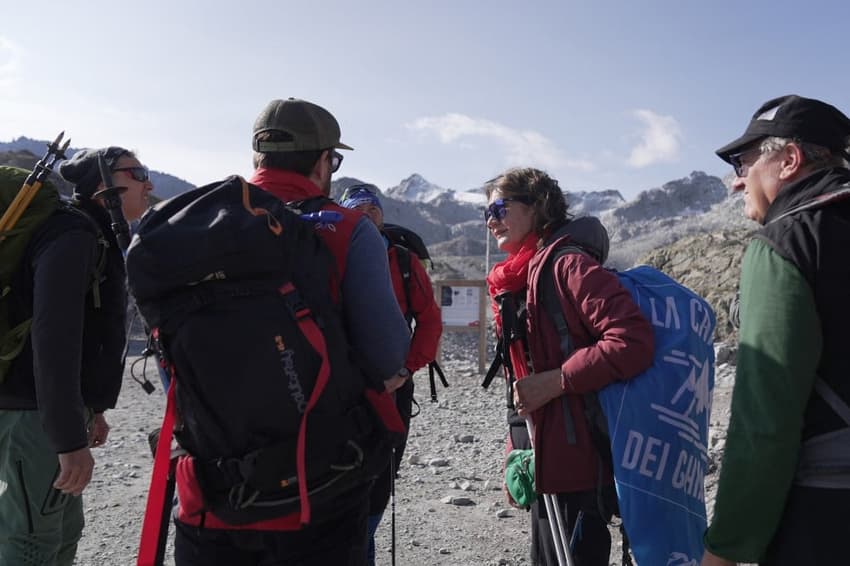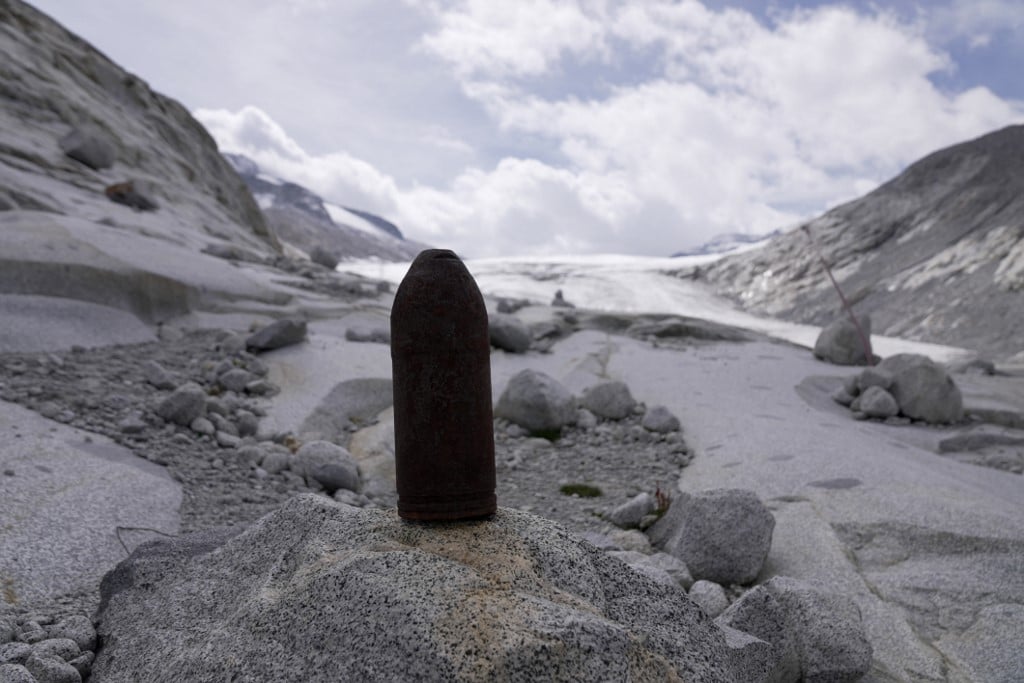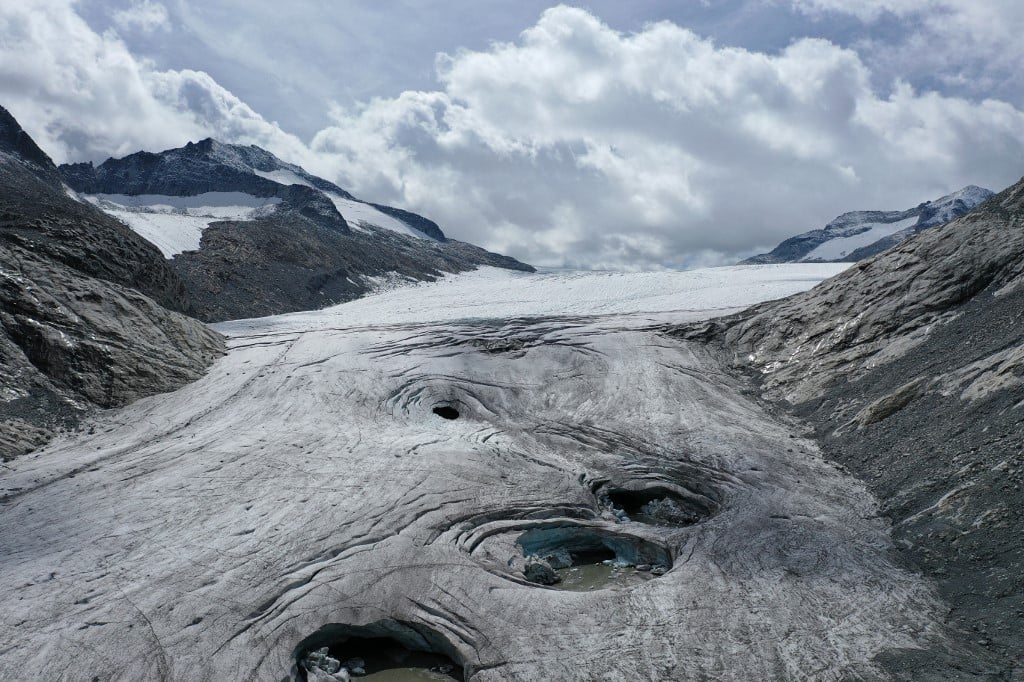IN PICTURES: Italy's largest glacier melting at 'incredible' pace

The Adamello glacier is rapidly retreating and could disappear altogether by the end of the century, current projections show. In the process, traces of its history are being uncovered.
The Adamello glacier, the largest in the Italian Alps, is slowly being destroyed by global warming, with experts giving it less than a century to survive.
"From the end of the 19th century until today, the glacier has lost approximately 2.7 kilometres," said Cristian Ferrari, president of the Glaciological Commission of the Tridentine Alpinists Society.
"In the last five years, we have had average losses of 15 metres per year. But last year alone (2022) we saw the loss of 139 metres in a year."

Scientists say the Adamello glacier has lost almost 2.7 km since the end of the 19th century. Photo by Andrea BERNARDI / AFP.
Every summer for the past four years, Italian environmental association Legambiente has organised a journey across the Alps to illustrate the effects of climate change on glaciers.
Like other Alpine glaciers, the Adamello is suffering from reduced snowfall - down 50 percent last year.
The snow cover is thinner, and longer and hotter summers give it less time to freeze.

Legambiente members hiking down from Presana pass towards the Val Genova with the Adamello glacier in the background on September 1st, 2023. Photo by Andrea BERNARDI / AFP.
The glacier is also splitting, proving more surface area exposed to the hot air.
It has also exposed traces of the mountains' history, as the scene of fierce battles between Italian and Austro-Hungarian fighters during World War I.
Today, rifles and shell cases emerge from the melting ice.
READ ALSO: French mayors ask climbers to stay away from Mont Blanc during heatwave

A photograph taken on September 1st, 2023 shows a World War I bullet that re-emerged from the glacier. Photo by Andrea BERNARDI / AFP.
"We read the traces of the past, we read the traces of the present and we recognise that the trend is not positive," said Marco Giardino, vice president of the Italian Glaciological Committee and a professor at Turin university.
"Because the blocks that we see fall today will transform that part of the glacier into a glacier covered with debris, and it will destabilise the side of the mountain."
Legambiente's annual "caravan" through the mountains, involving scientists and environmentalists, has covered several glaciers in the past four years.
READ ALSO: Climate crisis: '90 percent' of Europe's ski resorts face critical snow shortages
 The front part of the Vedretta del Madrone on the Adamello glacier on September 1st, 2023. Photo by Andrea BERNARDI / AFP.
The front part of the Vedretta del Madrone on the Adamello glacier on September 1st, 2023. Photo by Andrea BERNARDI / AFP.
"Last year we wanted to return to the glaciers we observed two years previously, and the change that we saw was incredible," said its manager for the Alps, Vanda Bonario.
Last year was marked by drought and heat "but we saw situations that I couldn't have imagined".
The Forni glacier in Lombardy, for example, had retreated by more than 100 metres, she said.

A climate change activist Legambiente members hiking with a flag on her shoulders and the Adamello glacier in the background on September 1st, 2023. Photo by Andrea BERNARDI / AFP.
"They (glaciers) truly convey to us to us an incredible impression of how climate change has accelerated, of the intensity of events, that is, everything is moving quickly."
According to the UN's Intergovernmental Panel on Climate Change (IPCC), temperatures in this part of the Alps will increase between one and three degrees Celsius in 2050 and between three and six degrees by the end of the century.
At this rate, the Adamello glacier could disappear before the end of the century.
Comments
See Also
The Adamello glacier, the largest in the Italian Alps, is slowly being destroyed by global warming, with experts giving it less than a century to survive.
"From the end of the 19th century until today, the glacier has lost approximately 2.7 kilometres," said Cristian Ferrari, president of the Glaciological Commission of the Tridentine Alpinists Society.
"In the last five years, we have had average losses of 15 metres per year. But last year alone (2022) we saw the loss of 139 metres in a year."

Every summer for the past four years, Italian environmental association Legambiente has organised a journey across the Alps to illustrate the effects of climate change on glaciers.
Like other Alpine glaciers, the Adamello is suffering from reduced snowfall - down 50 percent last year.
The snow cover is thinner, and longer and hotter summers give it less time to freeze.

The glacier is also splitting, proving more surface area exposed to the hot air.
It has also exposed traces of the mountains' history, as the scene of fierce battles between Italian and Austro-Hungarian fighters during World War I.
Today, rifles and shell cases emerge from the melting ice.
READ ALSO: French mayors ask climbers to stay away from Mont Blanc during heatwave

"We read the traces of the past, we read the traces of the present and we recognise that the trend is not positive," said Marco Giardino, vice president of the Italian Glaciological Committee and a professor at Turin university.
"Because the blocks that we see fall today will transform that part of the glacier into a glacier covered with debris, and it will destabilise the side of the mountain."
Legambiente's annual "caravan" through the mountains, involving scientists and environmentalists, has covered several glaciers in the past four years.
READ ALSO: Climate crisis: '90 percent' of Europe's ski resorts face critical snow shortages

"Last year we wanted to return to the glaciers we observed two years previously, and the change that we saw was incredible," said its manager for the Alps, Vanda Bonario.
Last year was marked by drought and heat "but we saw situations that I couldn't have imagined".
The Forni glacier in Lombardy, for example, had retreated by more than 100 metres, she said.

"They (glaciers) truly convey to us to us an incredible impression of how climate change has accelerated, of the intensity of events, that is, everything is moving quickly."
According to the UN's Intergovernmental Panel on Climate Change (IPCC), temperatures in this part of the Alps will increase between one and three degrees Celsius in 2050 and between three and six degrees by the end of the century.
At this rate, the Adamello glacier could disappear before the end of the century.
Join the conversation in our comments section below. Share your own views and experience and if you have a question or suggestion for our journalists then email us at [email protected].
Please keep comments civil, constructive and on topic – and make sure to read our terms of use before getting involved.
Please log in here to leave a comment.